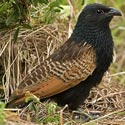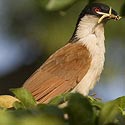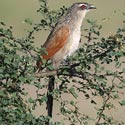|
Family: Centropodidae (coucals)
Life
> Eukaryotes >
Opisthokonta
> Metazoa (animals) >
Bilateria >
Deuterostomia > Chordata >
Craniata > Vertebrata (vertebrates) > Gnathostomata (jawed
vertebrates) > Teleostomi (teleost fish) > Osteichthyes (bony fish) > Class:
Sarcopterygii (lobe-finned
fish) > Stegocephalia (terrestrial
vertebrates) > Tetrapoda
(four-legged vertebrates) > Reptiliomorpha > Amniota >
Reptilia (reptiles) >
Romeriida > Diapsida > Archosauromorpha > Archosauria >
Dinosauria
(dinosaurs) > Saurischia > Theropoda (bipedal predatory dinosaurs) >
Coelurosauria > Maniraptora > Aves
(birds) > Order: Cuculiformes
Species indigenous to southern Africa
|
Centropus
burchellii (Burchell's coucal) The
Burchell's coucal is endemic, being found mainly in South Africa, living in
a wide variety of habitats. It is a voracious predator, feeding on small
birds, mammals, reptiles and insects. Interestingly, the male does more work
than the female, building the nest, incubating the eggs and doing most of
the hunting. The chick's feet develop quickly, and they are capable of
clambering around bushes long before they can fly. They usually leave the
nest at 21 days old, after which they are still dependent on their parents
for weeks. |
 |
|
Centropus
cupreicaudus (Coppery-tailed coucal)
The Coppery-tailed coucal is endemic to south-central Africa, occurring in a
small band from south-western Angola to the Caprivi Strip and northern
Botswana, preferring dense waterside vegetation. It eats a wide range of
animals, including grasshoppers, frogs and fish. The nest is a hastily built
ball of grass, placed in dense tangles of reed or grass, sometimes over
water. It lays 2-4 eggs, sometimes before the nest has been completed, and
are probably incubated by the male. The chicks are fed mainly locusts and
frogs by both parents, leaving the nest after about 17 days. |
 |
|
Centropus
grillii (Black coucal) The Black coucal
occupies large areas of sub-Saharan Africa, preferring moist, marshy
grassland, with little or no trees. In southern Africa it is scarce and
localised, and is now classified as near-threatened in South
Africa, due to habitat loss. It exclusively eats invertebrates, such
as grasshoppers, centipedes and spiders. It is mostly polyandrous, meaning
that one female can mate with multiple males, laying 2-6 eggs in a
cup-shaped nest built by the male. She then leaves for another male's
territory, leaving him to incubate the eggs, for about 14 days, and take
care of the chicks, who leave the nest at about 18-20 days old. |
 |
|
Centropus
senegalensis (Senegal coucal) |
 |
|
Centropus
superciliosus (White-browed coucal) The
White-browed coucal is fairly common in Zimbabwe, Botswana and Mozambique,
living in thick vegetation. It feeds on a wide a wide variety of animals,
such as mammals, birds and insects. The nest is large sphere with a side
entrance, made of grass blades or stems. It lays 3-5 eggs, which are
incubated by both sexes, for 14-16 days. For the first three days of their
life, the chicks are brooded by one parent, and fed by the other, after
which both the parents do the hunting. The brood leave the nest at 18-20
days old, the fledgling period has not been studied. |
 |
|
